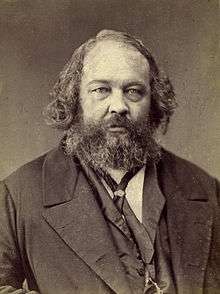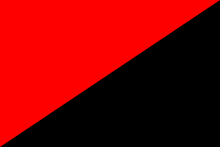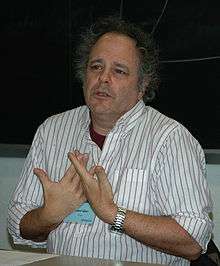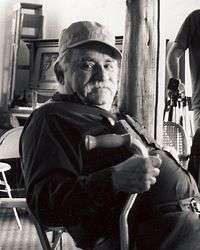Social anarchism
Social anarchism (sometimes referred to as socialist anarchism or anarcho-socialism)[1] is a non-state form of socialism[2] and is considered to be the branch of anarchism that sees individual freedom as being interrelated with mutual aid.[3]
Social anarchist thought emphasizes community and social equality as complementary to autonomy and personal freedom, through norms maintained, such as freedom of speech, in a decentralized federalism, balanced with freedom of interaction in thought.[3] It is, also, advocated that the conversion of a proportion of present-day (and future) productive private property be made into social property, to offer individual empowerment through easier access to such as tools or parts, or a sharing of the commons, while retaining respect for personal property.[4] The term is used to describe the theory—contra anarchist individualism— that places an emphasis on the communitarian and cooperative aspects in anarchist theory while, also, opposing authoritarian forms of communitarianism associated with groupthink and collective conformity, and instead favouring a reconciliation between individuality and sociality. Illegitimate authority is removed through inspection and vigilance. While self-determination is asserted, as is worker's self-management, and education and empowerment emphasized, both individually and through interaction with the community, a do-it-youself (DIY) mentality is combined with educational efforts within the social realm.
It is considered an umbrella term that includes (but is not limited to) the post-capitalist economic models of anarcho-communism, collectivist anarchism and (sometimes) mutualism, cooperatives, or market socialism; as well as the trade union approach of anarcho-syndicalism, the social struggle strategies of platformism and specifism and the environmental philosophy of social ecology.
The term "social anarchism" is often used interchangeably with libertarian socialism,[1] left-libertarianism[5] or left anarchism.[6] It emerged in the late 19th century as a distinction from individualist anarchism.[7]
Historical currents
Mutualism
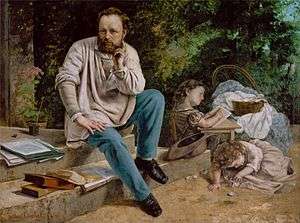
Mutualism, originally developed by Pierre-Joseph Proudhon, emerged from early 19th century socialism and is generally considered a market-oriented strand within the libertarian socialist tradition. Mutualists typically accept property rights, but with brief abandonment time periods. In a community in which mutuality property rules were upheld, a landowner would need to make (more or less) continuous use of his/her land; if he/she failed to do so, his/her ownership rights would be extinguished and the land could be homesteaded by someone else. A mutualist property regime is often described as one rooted in "possession", "occupancy-and-use", or "usufruct".[8]
Nevertheless, mutualism is also associated with the economic views of 19th century American individualist anarchists such as Benjamin Tucker and William Batchelder Greene.[9] Today, Kevin Carson is a contemporary mutualist and author of Studies in Mutualist Political Economy who describes this work as "an attempt to revive individualist anarchist political economy, to incorporate the useful developments of the last hundred years, and to make it relevant to the problems of the twenty-first century".[10]
Collectivist anarchism
Collectivist anarchism (also known as anarcho-collectivism)[11][12] is a revolutionary form of anarchism, commonly associated with Mikhail Bakunin and James Guillaume.[13][14] It is a specific tendency, not to be confused with the broad category sometimes called collectivist or communitarian anarchism.[15]
The tendency emerged from the most radical wing of mutualism during the late 1860s. Unlike mutualists, collectivist anarchists oppose all private ownership of the means of production, instead advocating that ownership be collectivized, being made the joint property of the commune (municipality). This was to be achieved through violent revolution, first starting with a small cohesive group through acts of armed insurrection, or "propaganda by the deed", which would inspire the workers and peasants as a whole to revolt and forcibly collectivize the means of production.[13] However, collectivization was not to be extended to the distribution of income as workers would be paid according to time worked, rather than receiving goods being distributed "according to need" as in anarcho-communism. This position was criticised by later anarcho-communists as effectively "uphold[ing] the wages system".[16]
Anarchist communist and collectivist ideas were not mutually exclusive. Although the collectivist anarchists advocated compensation for labor, some held out the possibility of a post-revolutionary transition to a communist system of distribution according to need, claiming that this would become more feasible once technology and productivity had evolved to a point where "production outstrips consumption" in a relative sense.[17] Collectivist anarchism arose contemporaneously with Marxism, but it opposed the Marxist dictatorship of the proletariat despite the stated Marxist goal of a collectivist stateless society.[18]
Anarcho-communism
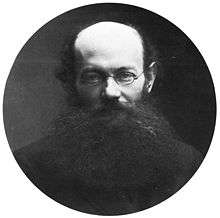
Anarcho-communism (also known as anarchist communism and occasionally as free communism) is a theory of anarchism that advocates the abolition of the state, markets, money, capitalism and private property.
Politically, anarchist communists advocate replacing the nation-state and representative government with a voluntary confederation of free communes (self-governing municipalities), with the commune replacing the nation as the core unit of social-political administration. Economically, anarchist communists believe in converting private property into the commons or public goods while retaining respect for personal property). In practice, this means common ownership of the means of production,[19][20] direct democracy with production organised through a horizontal network of voluntary associations and consumption based on the guiding principle: "From each according to his ability, to each according to his needs".[21][22] Some forms of anarchist communism such as insurrectionary anarchism are strongly influenced by egoism and radical individualism, believing anarcho-communism is the best social system for the realization of individual freedom.[23][24][25][26] Most anarcho-communists view anarcho-communism as a way of reconciling the opposition between the individual and society.[27][28][29]
The ideas associated with anarchist communism developed out of radical socialist currents after the French revolution,[30][31] but was first formulated as such in the Italian section of the First International.[32] The theoretical work of Peter Kropotkin took importance later as it expanded and developed pro-organizationalist and insurrectionary anti-organizationalist sections.[33]
In terms of its vision for a post-capitalist economy, it differs from anarcho-syndicalism in seeing the centre of political-economic organisation as the commune, rather than the workplace, with economic issues being administered primarily on a communal (territorial), rather than unionist (industrial), basis. Though most anarcho-syndicalists agree with the communist method of distribution—"From each according to his ability, to each according to his needs"—they disagree with the commune-based method of organising production and structuring society; making them communists in one sense, but not the other.
To date, the best known examples of an anarchist communist society (i.e. established around the ideas as they exist today and achieving worldwide attention and knowledge in the historical canon), are the anarchist territories during the Spanish Revolution[34] and the Free Territory during the Russian Revolution. Through the efforts and influence of the Spanish Anarchists during the Spanish Revolution within the Spanish Civil War, starting in 1936 anarchist communism existed in most of Aragon, parts of the Levante and Andalusia as well as in the stronghold of anarchist Catalonia before being crushed by the combined forces of the regime that won the war, Adolf Hitler, Benito Mussolini, Spanish Communist Party repression (backed by the Soviet Union) as well as economic and armaments blockades from the capitalist countries and the Spanish Republic itself.[35] During the Russian Revolution, anarchists such as Nestor Makhno worked to create and defend—through the Revolutionary Insurrectionary Army of Ukraine—anarchist communism in the Free Territory of the Ukraine from 1919 before being conquered by the Bolsheviks in 1921.
Anarcho-syndicalism
In the late 19th and early 20th century, revolutionary syndicalism emerged as a form of radical trade union activism, sharing a close relationship with social anarchists of both the collectivist and communist tendencies. In the early 1920s, anarcho-syndicalism arose as a distinct school of thought within anarchism.[36]
With greater focus on the labour movement than previous forms of anarchism, syndicalism posits radical trade unions as a potential force for revolutionary social change, replacing capitalism and the state with a new society, democratically self-managed by the workers.
Like anarchist-communists, anarcho-syndicalists seek to abolish the wage system and private ownership of the means of production, which they believe lead to class divisions. Important principles include workers' solidarity, direct action (such as general strikes and workplace recuperations) and workers' self-management of enterprises and the economy as a whole.
In terms of post-capitalist vision, anarcho-syndicalists most often subscribe to communist or collectivist anarchist economic systems on the issue of distributing goods.[37] The aim is to use a radical trade union movement to achieve either a collectivist or communist (moneyless) mode of distribution; or first the former and then the latter, once a certain degree of technical-productive capacity has enabled production to outstrip consumption, making a moneyless economy more viable. However, anarcho-syndicalists differ from anarcho-communists on wanting federations of (trade-based) workers' syndicates as the locus of organising the economy, rather than confederations of (territory-based) free communes.
Its advocates propose labour organization as a means to create the foundations of a trade union centered anarchist society within the current system and bring about social revolution. An early leading anarcho-syndicalist thinker was Rudolf Rocker, whose 1938 pamphlet Anarchosyndicalism outlined a view of the movement's origin, aims and importance to the future of labour.[37][38]
Although more often associated with labor struggles of the early 20th century (particularly in France and Spain), many syndicalist organizations are active today, united across national borders by membership in the International Workers' Association, including the Central Organisation of the Workers of Sweden in Sweden, the Italian Syndicalist Union in Italy, the National Confederation of Labour and the General Confederation of Labour in Spain, the Workers Solidarity Movement of Ireland and the Industrial Workers of the World in the United States.
Platformism and specifism
Platformism is a tendency (or organized school of thought) within the anarchist movement which stresses the need for tightly organized anarchist organizations that are able to influence working class and peasant movements to achieve anarchist communism.
It is in many ways identical to specifism (especifismo) and has an antecedent in the work of Mikhail Bakunin, advocating a strategy of "organisational dualism", which entails: (1) building specifically anarchist organisations with a general agreement on ideas and practices; and (2) anarchists working within broader popular organisations and movements that aren't specifically anarchist, hoping to maintain theoretical consistency as well as pushing popular movements in a more anarchistic direction from within.
Platformist/specifist groups reject the model of Leninist vanguardism. They instead aim to "make anarchist ideas the leading ideas within the class struggle".[39] According to the Organisational Platform for a General Union of Anarchists, the four main principles by which an anarchist organisation should operate are ideological unity, tactical unity, collective responsibility and federalism.
In general, these groups aim to win the widest possible influence for anarchist ideas and methods in the working class and peasantry (the popular classes), oriented towards "ordinary" people, rather than to the extreme left milieu. This usually entails a willingness to work in single-issue campaigns, trade unionism and community groups and to fight for immediate reforms while linking this to a project of building popular consciousness and organisation. They therefore reject approaches that they believe will prevent this, such as insurrectionist anarchism, as well as "views that dismiss activity in the unions" or that dismiss anti-imperialist movements.[40]
The name "platformist" derives from the 1926 Organisational Platform of the General Union of Anarchists (Draft).[41] This was published by the Group of Russian Anarchists Abroad, in their journal Dielo Truda ("Workers' Cause" in Russian). The group, which consisted of exiled Russian anarchist veterans of the 1917 October Revolution (notably Nestor Makhno who played a leading role in the anarchist revolution in the Ukraine of 1918–1921), based the Platform on their experiences of the revolution and the eventual victory of the Bolsheviks over the anarchists and other groups. The Platform attempted to address and explain the anarchist movement's failures during the Russian Revolution outside of the Ukraine.
The document drew both praise and criticism from anarchists worldwide and sparked a major debate within the anarchist movement.[42] Today, platformism is an important current in international anarchism. Around thirty platformist and specifist organisations are linked together in the Anarkismo.net project, including groups from Africa, Latin America, North America and Europe.[40]
Contemporary currents
More recent developments within social anarchism are the post-capitalist economic models of inclusive democracy and participatory economics, both of which could be regarded as updated forms of the collectivist anarchism of Mikhail Bakunin as well as the environmental philosophy of social ecology and its associated politics of Post-Scarcity Anarchism and Communalism.
Inclusive Democracy
Inclusive Democracy is a political theory and political project that aim for direct democracy, economic democracy in a stateless, moneyless and marketless economy, self-management (democracy in the social realm) and ecological democracy. The theoretical project of Inclusive Democracy (ID; as distinguished from the political project that is part of the democratic and autonomy traditions) emerged from the work of political philosopher, former academic and activist Takis Fotopoulos in Towards An Inclusive Democracy and was further developed by him and other writers in the journal Democracy & Nature and its successor The International Journal of Inclusive Democracy, an electronic journal freely available and published by the International Network for Inclusive Democracy.
According to Arran Gare, Towards an Inclusive Democracy "offers a powerful new interpretation of the history and destructive dynamics of the market and provides an inspiring new vision of the future in place of both neo-liberalism and existing forms of socialism".[43] As David Freeman points out, although Fotopoulos' approach "is not openly anarchism, yet anarchism seems the formal category within which he works, given his commitment to direct democracy, municipalism and abolition of state, money and market economy".[44]
Participism
Participism is a 21st century form of libertarian socialism which comprises two related economic and political systems called participatory economics or "parecon" and participatory politics or "parpolity".
Parecon is an economic system proposed primarily by activist and political theorist Michael Albert and radical economist Robin Hahnel, among others. It uses participatory decision making as an economic mechanism to guide the production, consumption and allocation of resources in a given society. Proposed as an alternative to contemporary capitalist market economies and also an alternative to centrally planned socialism or coordinatorism, it is described as "an anarchistic economic vision" and it could be considered a form of socialism as under Parecon, the means of production are owned by the workers. The underlying values that Parecon seeks to implement are equity, solidarity, diversity, workers' self-management and efficiency (efficiency here means accomplishing goals without wasting valued assets). It proposes to attain these ends mainly through the following principles and institutions: workers' and consumers' councils utilizing self-managerial methods for decision making, balanced job complexes, remuneration according to effort and sacrifice and participatory planning.
Under parecon, the current monetary system would be replaced with a system of non-transferable "credit", which would cease to exist upon purchase of a commodity.
Parpolity is a theoretical political system proposed by Stephen R. Shalom. It was developed as a political vision to accompany Parecon. The values on which parpolity is based are freedom, self-management, justice, solidarity and tolerance. According to Shalom, the goal is to create a political system that will allow people to participate as much as possible in a face to face manner. Participism as a whole is critical of aspects of modern representative democracies and capitalism arguing that the level of political control by the people is not sufficient. To address this problem, parpolity suggests a system of "Nested Councils", which would include every adult member of a given society. With five levels of nested councils it is thought, could represent the population of the United States.
Under participism, the state as such would dissolve into a mere coordinating body made up of delegates, who would be recallable at any time by the nested council below them.
Social ecology and Communalism
Social ecology is closely related to the work and ideas of Murray Bookchin and influenced by anarchist Peter Kropotkin. Social ecologists assert that the present ecological crisis has its roots in human social problems and that the domination of human-over-nature stems from the domination of human-over-human.[45]
Bookchin later developed a political philosophy to complement social ecology that he called Communalism (spelled with a capital "C" to differentiate it from other forms of communalism). While originally conceived as a form of social anarchism, he later developed Communalism into a separate ideology that incorporates what he saw as the most beneficial elements of anarchism, Marxism, syndicalism and radical ecology.
Politically, Communalists advocate a network of directly democratic citizens' assemblies in individual communities/cities organized in a confederal fashion. This method used to achieve this is called libertarian municipalism, which involves the establishment of face-to-face democratic institutions that are to grow and expand confederally with the goal of eventually replacing the nation state. Unlike anarchists, Communalists are not opposed to taking part in parliamentary politics—especially municipal elections—as long as candidates are libertarian socialist and anti-statist in outlook.
Economically, Communalism favours the abolition of markets and money and the transition to an economy similar to libertarian communism and according to the principle "From each according to his ability, to each according to needs".
See also
- Social anarchists (category)
References
- 1 2 Ostergaard, Geoffrey. "Anarchism". The Blackwell Dictionary of Modern Social Thought. Blackwell Publishing. p. 14.
- ↑ Busky, Donald F. (January 1, 2000). Democratic Socialism: A Global Survey. Greenwood Publishing Group. p. 2. ISBN 9780275968861.
The same may be said of anarchism: social anarchism—a nonstate form of socialism—may be distinguished from the nonsocialist, and, in some cases, procapitalist school of individualist anarchism.
- 1 2 Suissa, Judith(2001) "Anarchism, Utopias and Philosophy of Education" Journal of Philosophy of Education 35 (4), 627–46. doi:10.1111/1467-9752.00249
- ↑ "The revolution abolishes private ownership of the means of production and distribution, and with it goes capitalistic business. Personal possession remains only in the things you use. Thus, your watch is your own, but the watch factory belongs to the people."Alexander Berkman. "What Is Communist Anarchism?"
- ↑ Bookchin, Murray (1995). Social Anarchism Or Lifestyle Anarchism: An Unbridgeable Chasm. AK Press.
- ↑ Thagard, Paul. 2002. Coherence in Thought and Action. MIT Press. p. 153
- ↑ "No, far from it. Most anarchists in the late nineteenth century recognised communist-anarchism as a genuine form of anarchism and it quickly replaced collectivist anarchism as the dominant tendency. So few anarchists found the individualist solution to the social question or the attempts of some of them to excommunicate social anarchism from the movement convincing."An anarchist FAQ by Various Authors
- ↑ On mutualism, see, e.g., Pierre-Joseph. Proudhon, What Is Property?, trans. Benjamin R. Tucker (New York: Humboldt 1890).
- ↑ For American anarchist historian Eunice Minette Schuster "It is apparent ... that Proudhonian Anarchism was to be found in the United States at least as early as 1848 and that it was not conscious of its affinity to the Individualist Anarchism of Josiah Warren and Stephen Pearl Andrews ... William B. Greene presented this Proudhonian Mutualism in its purest and most systematic form."Native American Anarchism: A Study of Left-Wing American Individualism by Eunice Minette Schuster Archived 13 February 2016 at the Wayback Machine.
- ↑ "Archived copy". Archived from the original on 21 December 2010. Retrieved 22 January 2007. Kevin Carson. Studies in Mutualist Political Economy.
- ↑ Morris, Brian. Bakunin: The Philosophy of Freedom. Black Rose Books Ltd., 1993. p. 76.
- ↑ Rae, John. Contemporary Socialism. C. Scribner's sons, 1901, Original from Harvard University. p. 261.
- 1 2 Patsouras, Louis. 2005. Marx in Context. iUniverse. p. 54.
- ↑ Avrich, Paul. 2006. Anarchist Voices: An Oral History of Anarchism in America. AK Press. p. 5.
- ↑ Morris, Christopher W. 1998. An Essay on the Modern State. Cambridge University Press. p. 50. The collectivist category is also sometimes known as social, socialist, or communitarian anarchism category.
- ↑ Kropotkin, Peter (2007). "13". The Conquest of Bread. Edinburgh: AK Press. ISBN 978-1-904859-10-9.
- ↑ Guillaume, James (1876). "Ideas on Social Organization".
- ↑ Bakunin, Mikhail (1990). Statism and Anarchy. Cambridge: Cambridge University Press. ISBN 0-521-36182-6.
They [the Marxists] maintain that only a dictatorship—their dictatorship, of course—can create the will of the people, while our answer to this is: No dictatorship can have any other aim but that of self-perpetuation, and it can beget only slavery in the people tolerating it; freedom can be created only by freedom, that is, by a universal rebellion on the part of the people and free organization of the toiling masses from the bottom up.
- ↑ Alan James Mayne (1999). From Politics Past to Politics Future: An Integrated Analysis of Current and Emergent Paradigms. Greenwood Publishing. ISBN 978-0-275-96151-0. Retrieved 2010-09-20.
- ↑ Anarchism for Know-It-Alls. Filiquarian Publishing. 2008. ISBN 978-1-59986-218-7. Retrieved 2010-09-20.
- ↑ Fabbri, Luigi. "Anarchism and Communism." Northeastern Anarchist #4. 1922. 13 October 2002. http://dwardmac.pitzer.edu/anarchist_archives/worldwidemovements/fabbrianarandcom.html
- ↑ Makhno, Mett, Arshinov, Valevski, Linski (Dielo Trouda). "The Organizational Platform of the Libertarian Communists". 1926. Constructive Section: available here http://www.nestormakhno.info/english/platform/constructive.htm
- ↑ Christopher Gray, Leaving the Twentieth Century, p. 88.
- ↑ "Towards the creative Nothing" by Renzo Novatore
- ↑ Post-left anarcho-communist Bob Black after analysing insurrectionary anarcho-communist Luigi Galleani's view on anarcho-communism went as far as saying that "communism is the final fulfillment of individualism...The apparent contradiction between individualism and communism rests on a misunderstanding of both...Subjectivity is also objective: the individual really is subjective. It is nonsense to speak of "emphatically prioritizing the social over the individual,"...You may as well speak of prioritizing the chicken over the egg. Anarchy is a "method of individualization." It aims to combine the greatest individual development with the greatest communal unity."Bob Black. Nightmares of Reason.
- ↑ "Modern Communists are more individualistic than Stirner. To them, not merely religion, morality, family and State are spooks, but property also is no more than a spook, in whose name the individual is enslaved—and how enslaved!...Communism thus creates a basis for the liberty and Eigenheit of the individual. I am a Communist because I am an Individualist. Fully as heartily the Communists concur with Stirner when he puts the word take in place of demand—that leads to the dissolution of property, to expropriation. Individualism and Communism go hand in hand."Max Baginski. "Stirner: The Ego and His Own" on Mother Earth. Vol. 2. No. 3 May 1907
- ↑ "Communism is the one which guarantees the greatest amount of individual liberty—provided that the idea that begets the community be Liberty, Anarchy...Communism guarantees economic freedom better than any other form of association, because it can guarantee wellbeing, even luxury, in return for a few hours of work instead of a day's work." "Communism and Anarchy" by Peter Kropotkin
- ↑ This other society will be libertarian communism, in which social solidarity and free individuality find their full expression, and in which these two ideas develop in perfect harmony.Organisational Platform of the Libertarian Communists by Dielo Truda (Workers' Cause)
- ↑ "I see the dichotomies made between individualism and communism, individual revolt and class struggle, the struggle against human exploitation and the exploitation of nature as false dichotomies and feel that those who accept them are impoverishing their own critique and struggle.""My Perspectives" by Willful Disobedience Vol. 2, No. 12 Archived 29 July 2011 at WebCite
- ↑ Graham, Robert (2005). Anarchism: From anarchy to anarchism (300 CE to 1939). Black Rose Books. ISBN 1551642506.
- ↑ "Chapter 41: The "Anarchists"" in The Great French Revolution 1789–1793 by Peter Kropotkin
- ↑ Nunzio Pernicone, "Italian Anarchism 1864–1892", pp. 111–13, AK Press 2009.
- ↑ "Anarchist-Communism" by Alain Pengam
- ↑ "This process of education and class organization, more than any single factor in Spain, produced the collectives. And to the degree that the CNT-FAI (for the two organizations became fatally coupled after July 1936) exercised the major influence in an area, the collectives proved to be generally more durable, communist and resistant to Stalinist counterrevolution than other republican-held areas of Spain." Murray Bookchin. To Remember Spain: The Anarchist and Syndicalist Revolution of 1936.
- ↑ Murray Bookchin. To Remember Spain: The Anarchist and Syndicalist Revolution of 1936.
- ↑ Berry, David, A History of the French Anarchist Movement, 1917–1945 p. 134.
- ↑ Anarchosyndicalism by Rudolf Rocker. Retrieved 7 September 2006.
- ↑ Workers Solidarity Movement, 2012, "Why You Should Join the Workers Solidarity Movement" |url=http://flag.blackened.net/revolt/once/join.html |accessdate=5 January 2012|
- 1 2 Anarkismo, 2012, "About Us" |url=http://www.anarkismo.net/about_us |accessdate=5 January 2012|
- ↑ Dielo Truda group (2006) [1926]. Organizational Platform of the General Union of Anarchists (Draft). Ireland: Nestor Makhno Archive. Retrieved 5 January 2012.
- ↑ Schmidt, M. and van der Walt, L. 2009. Black Flame: The Revolutionary Class Politics of Anarchism and Syndicalism (Counter-Power vol. 1). Edinburgh: AK Press. pp. 252–55
- ↑ Arran Gare, "Beyond Social Democracy? Takis Fotopoulos' Vision of an Inclusive Democracy as a New Liberatory Project" Archived 6 July 2011 at the Wayback Machine. Democracy & Nature, Vol. 9, No. 3 (November 2003), pp. 345–58 (14)
- ↑ David Freeman, "Inclusive democracy and its prospects" review of book Towards An Inclusive Democracy: The Crisis of the Growth Economy and the Need For a New Liberatory Project, published in Thesis Eleven, Sage Publications, no. 69 (May 2002), pp. 103–06.
- ↑ Bookchin, Murray (1994). The Philosophy of Social Ecology: Essays on Dialectical Naturalism. Black Rose Books. pp. 119–20. ISBN 978-1-55164-018-1.
External links
| Wikiquote has quotations related to: Social anarchism |



